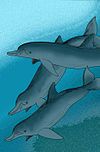User:Abyssal/Portal:Neogene
IntroductionSelected article on the Neogene world and its legacies
Ctenophora is a phylum of marine animals characterized by "combs" consisting of cilia they use for swimming. Adults range from a few millimeters to 1.5 m (4 ft 11 in) in size. Their bodies consist of a mass of jelly, with one layer two cells thick on the outside and another lining the internal cavity. Almost all ctenophores consume tiny animal prey. The phylum has a wide range of body forms, including the egg-shaped cydippids with retractable tentacles that capture prey, the flat generally combless platyctenids, and the large-mouthed beroids, which prey on other ctenophores.
Despite their soft, gelatinous bodies, fossils thought to represent ctenophores have been found in lagerstätten as far back as the early Cambrian, about 525 million years ago. The position of the ctenophores in the tree of life has long been debated, and the majority view at present, based on molecular phylogenetics, is that ctenophores are more primitive than the sponges, which are more primitive than the cnidarians and bilaterians. A recent molecular phylogenetics analysis concluded that the common ancestor of all modern ctenophores was cydippid-like, and that all the modern groups appeared relatively recently, probably after the Cretaceous–Paleogene extinction event 66 million years ago. Evidence accumulating since the 1980s indicates that the "cydippids" are not monophyletic, in other words do not include all and only the descendants of a single common ancestor, because all the other traditional ctenophore groups are descendants of various cydippids. (see more...) Did you know?
Need help?Do you have a question about Abyssal/Portal:Neogene that you can't find the answer to? Consider asking it at the Wikipedia reference desk. Selected image
Selected article on the Neogene in human science, culture and economicsThe Bone Wars is the name given to a period of intense fossil speculation and discovery during the Gilded Age of American history, marked by a heated rivalry between Edward Drinker Cope and Othniel Charles Marsh. The two paleontologists used underhanded methods to out-compete the other in the field, resorting to bribery, theft, and destruction of bones. The scientists also attacked each other in scientific publications, attempting to ruin the other's credibility and cut off his funding. Originally colleagues who were civil to each other, Cope and Marsh became bitter enemies after several personal slights between them. Their pursuit of bones led them west to rich bone beds in Colorado, Nebraska, and Wyoming. From 1877 to 1892, both paleontologists used their wealth and influence to finance their own expeditions and to procure services and fossils from dinosaur hunters. By the end of the Bone Wars, both men exhausted their funds in fueling their intense rivalry. Cope and Marsh were financially and socially ruined by their efforts to disgrace each other, but their contributions to science and the field of paleontology were massive; the scientists left behind tons of unopened boxes of fossils on their deaths. The feud between the two men led to over 142 new species of dinosaurs being discovered and described. Several historical books and fictional adaptations have also been published about this period of intense paleontological activity. (see more...) TopicsGeochronology - Neogene (Miocene - Pliocene) Neogene landmasses - Major Neogene events - Neogene biota appearances - Fossil sites - Stratigraphic units - History - History of paleontology - Timeline of paleontology Researchers - Culture - Treatise on Invertebrate Paleontology - Vertebrate Paleontology SubcategoriesQuality ContentFeatured Neogene articles - None yet Good Neogene articles - Nonet yet Things you can doWikiProjects
Related contentAssociated WikimediaThe following Wikimedia Foundation sister projects provide more on this subject:
|























